2024 The Kurihashi-shuku Associated Archaeological Site Cluster
Kuki City, Saitama Prefecture
Early to Late Edo period (early 17th century to late 19th century)
Rediscovering a Post Town of the Nikkō Kaidō
Located in the northeastern part of Saitama Prefecture, the Kurihashi-shuku Associated Archaeological Site Cluster comprises the Kurihashi-shuku Site, Kurihashi-shuku Honjin Site, Kurihashi-shuku Nishihonjin Site, Kurihashi Checkpoint Guard Residence Site, and the Kita 2-Chome Jinya Site. These sites are related to Kurihashi-shuku, a post town along the Nikkō Kaidō (or Nikkō Dōchū) a road that connected Edo (present-day Tokyo) to Nikkō. Situated near a crossing point on the Tone River and adjacent to a checkpoint, Kurihashi-shuku was an important stop along the road.
Excavations began in 2012 (Heisei 24) as part of an embankment expansion project on the Tone River and were completed in 2023 (Reiwa 5). The excavation covered an area of over 50,000 square meters, extending more than 700 meters north to south along the road. The focus of the investigation was the backyards of machiya (townhouses) set back slightly from the road, though the study also included the Honjin, a lodging for daimyō (feudal lords), and the Gozu Tennō Shrine (Kita 2-Chome Jinya Site).
The excavated remains date from the early Edo period to the Meiji era, with a concentration of features from the late Edo period (mid-18th to mid-19th century). Numerous pits interpreted as refuse dumps were uncovered, yielding large quantities of ceramics and wooden artifacts. Pits filled with burned soil and charred tiles are thought to represent evidence of fire cleanup. Notably, fires during the early 19th century, particularly in the Bunka and Bunsei eras, caused significant damage, and the subsequent reconstruction appears to have included the establishment of boundary markers. The town’s layout, which remains in place today, was finalized during this period.
Around the Honjin site, many ceramics destroyed by fire were recovered. These included matching sets of long plates, grilling plates, lidded bowls, small mortars, and Chinese porcelain dishes, showcasing elaborate designs.
According to local historical documents, a fire in 1822 (Bunsei 5) destroyed all “provisions and related utensils” which corresponds with the evidence recovered during excavation. Burnt ceramic bowls and plates were excavated from the surrounding townhouses, and these are believed to have been used for serving food and drinks in the post town. The sheer volume of these items highlights the post town’s development as a commercial space.
Artifacts related to trade include porcelain pieces inscribed with shop names such as “Toraya” “Itaya” and “Yoshidaya” in blue underglaze, which were discovered across the site. Reflecting the unique character of a post town, many rare artifacts for the region were unearthed, including Belgian soft-paste porcelain plates, Chinese porcelain medicine bottles, and cosmetic containers labeled “Asabeni” (light red rouge). Additionally, numerous glass and metal hair ornaments, handheld mirrors, and a substantial quantity of earthen dolls and toys were recovered, further emphasizing the diversity of the finds.
These abundant and varied artifacts provide invaluable insights into the movement of people and goods through the post town during the late Edo period. This large-scale excavation is unparalleled nationally in its scope for studying early modern post towns. The composition of the artifacts reflects differences in the functions of the honjin and townhouses. Within the townhouses, areas designated for hatago (traveler lodgings) were found to contain many old storehouses, demonstrating how the structures and artifacts reflected their respective trades and uses.
The findings from this excavation are expected to play a vital role in advancing research and reconstruction efforts related to Edo-period post towns. (Murayama Taku)
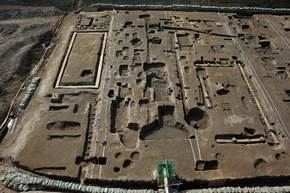
District facility of the post town (viewed from the east)
The vertical white line marks the boundary of the district facility. This is believed to be a trench where wooden walls were secured with stakes, although most of the structure was found with only the stakes remaining. The “L”-shaped feature at the upper left is thought to be the foundation of a solid building, possibly a warehouse.

Site Plan of Kurihashishuku Post Town, Location 9:The area outlined in red corresponds to the photo above
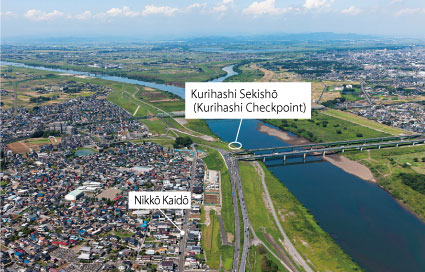
View of the site from the south
Upstream of Kurihashishuku, the Tone River (left) and Watarase River (right) converge, increasing the water volume as they flow southward towards Chōshi in Chiba Prefecture. The National Route 4, running along the levee, turns right and enters Koga City in Ibaraki Prefecture. Here, the Nikkō Kaidō also enters from Musashi no Kuni and connects with the lower part of Shimōsa no Kuni.
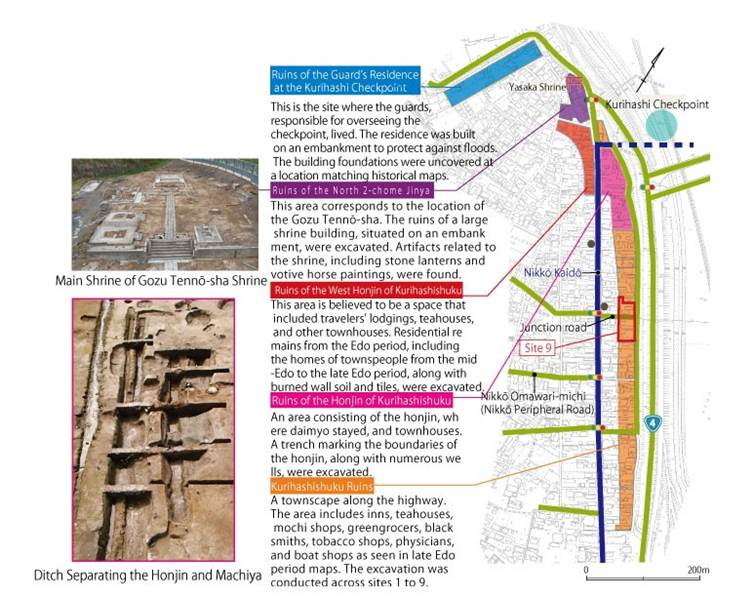
Excavation Site Location
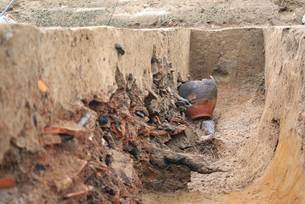
Ceramic and tile debris discarded after fire (Kurihashishuku Honjin Site)
A pit within the Honjin site where it is presumed that waste from the fire was discarded. Among the burnt soil, a set of ceramic plates, including porcelain plates of the Hizen style (top of page 104), was discovered. This combination of plates is only found at the Honjin site in Kurihashishuku, suggesting they were discarded in the aftermath of the fire that caused significant damage to the Honjin in the fifth year of Bunsei (1822).
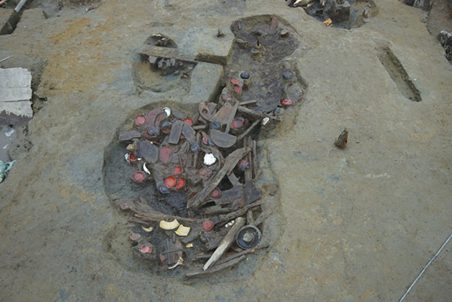
Excavation of lacquered bowls and wooden items (Kurihashishuku Nishi Honjin Site)
Due to the high groundwater level, many wooden items that would not normally survive on the upland area were preserved. At a location thought to be an inn, a large number of lacquered bowls and hanging racks were found. There were also many inscribed documents written in ink.
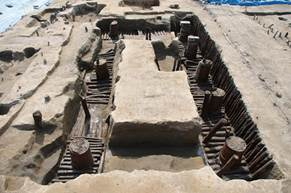
Foundation of a building thought to be a storehouse (Kurihashishuku Site)
In what is called a “barrel method” (taru jigyō), reused barrels were buried, and both the inside and outside were packed with small gravel. It is believed that a storehouse was built on top. This area was a section with an inn, and from the same area, a set of brightly colored Chinese porcelain, known as “Jikin,” was found. The artifacts date back to the late Edo period.
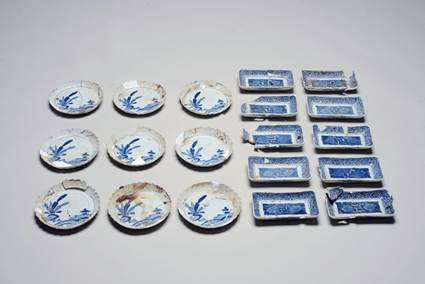
Hizen-style porcelain dishes (Kurihashishuku Honjin Site)
Found in a pit within the honjin grounds. The set consists of nine round plates and ten long plates. The design is not commonly found in this archaeological group. Based on the appearance of fused fragments, it is suspected that these dishes were stored stacked together and broken in the fire. The long plate in the lower right has a length of approximately 20 cm. Mid-Edo period (early 18th century).
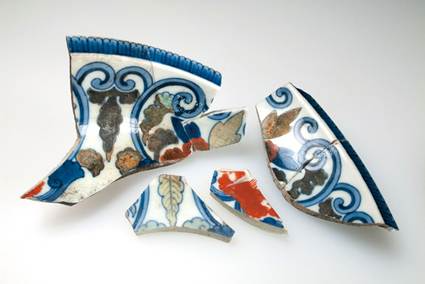
Nabeshima ware color-painted plate (Kurihashishuku Honjin Site)
This is Nabeshima ware, produced at the official kilns of the Hizen Nabeshima clan. As a high-quality ceramic, it was used as a gift for the shogunate and daimyō families. The four fragments belong to a single piece, featuring a design of peonies and chrysanthemums on the front, and a seven-petaled connected pattern (Shippōtsunagimon) on the back. The front is also adorned with red and green overglaze decorations. The origins of how this piece came to be at Kurihashishuku are particularly intriguing. The largest fragment has a width of 8.5 cm. Mid-Edo period (early 18th century).
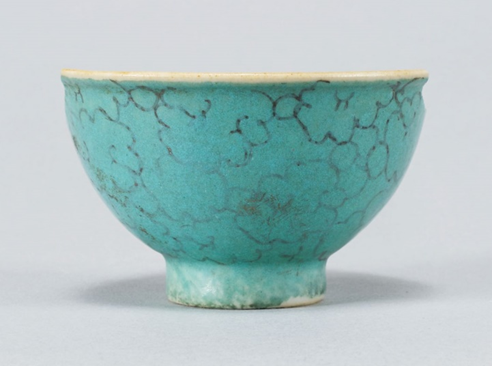
Qing Dynasty Chinese porcelain small bowl (Kurihashishuku Honjin Site)
This small bowl was popular among literati during the late Edo period for drinking sencha tea. It was produced in Jingdezhen, China, using a technique called fencai, where green colors are applied. It is also referred to as Jūkinte (Ten-kins). Such bowls are rarely found outside the Edo region. The bowl’s dimensions are: mouth diameter 6.8 cm, height 4.2 cm, and bottom diameter 2.6 cm.
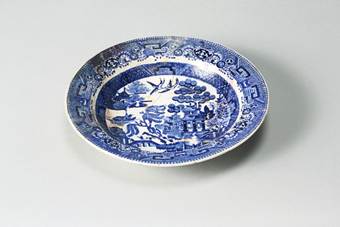
Belgian Soft-paste Porcelain Plate (Kurihashishuku Honjin Site)
The plate features a design known as the “Willow Pattern,” depicting a Chinese tragic love story, a motif popular in the Oriental style. The mark on the back suggests it was made by the Belgian company Boch Frères. It was found in the area believed to be part of a tavern, indicating it might have been one of its possessions. The plate’s diameter is 23.4 cm. Late Edo period (mid-19th century).
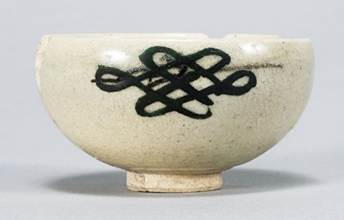
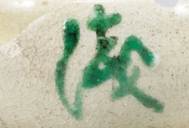

Kyoto Shigaraki-type Ceramic Cup with the Inscription Asa Beni (Kurihashishuku Honjin Ruins)
More than 100 cups bearing the inscriptions “浅” (Asa) and “紅” (Beni) were unearthed. The decorative pattern of the “treasure knot” / endless knot that accompanies the text matches the trademark of the “Asakusa Beniya” shop, which was featured in the publication ‘Edo Kaimono Hitori Annai’, suggesting that these were likely products of Beniya, which specialized in red (benibana) products. The meaning of Asa Beni refers to a light or pale red shade, which is a distinctive color. Such items rarely appear outside the Edo region, making it curious why so many of these items were found in Kurihashishuku. The cup measures 6.5 cm in diameter, 3.8 cm in height, and 2.3 cm in base diameter. This artifact dates to the late Edo period (late 18th century to early 19th century).
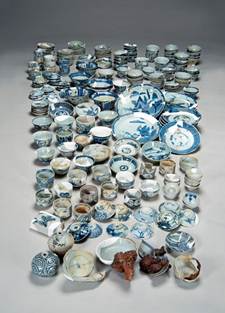
Ceramics believed to have been used in the townhouses (Kurihashishuku Nishi Honjin Ruins)
Across the Nikkō Kaidō from the Honjin, there was a townhouse space that included inns and teahouses. A large number of discarded items from the fires during the Bunka and Bunsei eras were excavated within this area. Unlike the finds from the Honjin, many medium-sized plates and lidded bowls were discovered.
